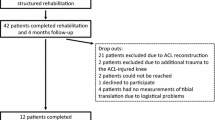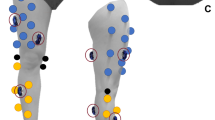Abstract
Purpose
This study aimed to investigate the effects of genu recurvatum, which is considered to carry a high risk for anterior cruciate ligament (ACL) injury, on healthy and post-ACL injury gait and lower extremity muscle strength.
Methods
Subjects were 36 patients with ACL-deficient knee and 40 healthy controls without pain or restricted range of motion of the lower extremity during gait. The knee joints of all subjects were examined; those with over 10° hyperextension of both knees were defined as exhibiting genu recurvatum. On this basis, the subjects were further subdivided into two groups: with or without genu recurvatum. A three-dimensional motion analysis system and force plates were used for gait analysis. Isokinetic dynamometers were used to measure knee muscle strength.
Results
There were no differences in joint angles, joint moments, or components of ground reaction force during gait or in knee strength for the healthy control subjects with and without genu recurvatum. ACL-deficient subjects without genu recurvatum showed a decrease in knee angles during the stance phase and a decrease in extension moments during the early stance phase compared with ACL-deficient subjects with genu recurvatum and controls. In contrast, neither knee angles nor extension moments during the stance phase differed significantly between ACL-deficient subjects with genu recurvatum and controls.
Conclusions
This study provides clinically relevant information regarding the effects of genu recurvatum on gait parameters. The results suggest that in ACL injuries, the presence of genu recurvatum alters gait pattern. Consideration of the presence of genu recurvatum would be useful during rehabilitation following ACL injuries or ACL reconstruction.
Level of evidence
II. Prospective comparative study.


Similar content being viewed by others
References
Ageberg E, Fridén T (2008) Normalized motor function but impaired sensory function after unilateral non-reconstructed ACL injury: patients compared with uninjured controls. Knee Surg Sports Traumatol Arthrosc 16:449–456
Alkjær T, Simonsen EB, Jørgensen U, Dyhre-Poulsen P (2003) Evaluation of the walking pattern in two types of patients with anterior cruciate ligament deficiency: copers and non-copers. Eur J Appl Physiol 89:301–308
Alkjær T, Henriksen M, Simonsen EB (2010) Different knee joint loading patterns in ACL deficient copers and non-copers during walking. Knee Surg Sports Traumatol Arthrosc 19:615–621
Andriacchi TP, Alexander EJ, Toney MK, Dyrby C, Sum J (1998) A point cluster method for in vivo motion analysis: applied to a study of knee kinematics. J Biomech Eng 120:743–749
Andriacchi TP, Birac D (1993) Functional testing in the anterior cruciate ligament-deficient knee. Clin Orthop Relat Res 288:40–47
Beard DJ, Soundarapandian RS, O’Connor JJ, Dodd CAF (1996) Gait and electromyographic analysis of anterior cruciate ligament deficient subjects. Gait Posture 4:83–88
Benedetti MG, Bonato P, Catani F, D’Alessio T, Knaflitz M, Marcacci M, Simoncini L (1999) Myoelectric activation pattern during gait in total knee replacement: relationship with kinematics, kinetics, and clinical outcome. IEEE Trans Rehabil Eng 7:140–149
Berchuck M, Andriacchi T, Bach B, Reider B (1990) Gait adaptations by patients who have a deficient anterior cruciate ligament. J Bone Joint Surg Am 72:871–877
Brandsson S, Karlsson J, Eriksson BI, Kärrholm J (2001) Kinematics after tear in the anterior cruciate ligament: dynamic bilateral radiostereometric studies in 11 patients. Acta Orthop Scand 72:372–378
Bulgheroni P, Bulgheroni MV, Andrini L, Guffanti P, Castelli C (1997) Walking in anterior cruciate ligament injuries. Knee 4:159–165
Bulgheroni P, Bulgheroni MV, Andrini L, Guffanti P, Giughello A (1997) Gait patterns after anterior cruciate ligament reconstruction. Knee Surg Sports Traumatol Arthrosc 5:14–21
Butler DL, Noyes FR, Grood ES (1980) Ligamentous restraints to anterior-posterior drawer in the human knee. A biomechanical study. J Bone Joint Surg Am 62:259–270
Chmielewski TL, Hurd WJ, Snyder-Mackler L (2005) Elucidation of a potentially destabilizing control strategy in ACL deficient non-copers. J Electromyogr Kinesiol 15:83–92
Davis RB, Õunpuu S, Tyburski D, Gage JR (1991) A gait analysis data collection and reduction technique. Hum Mov Sci 10:575–587
Ferber R, Osternig LR, Woollacott MH, Wasielewski NJ, Lee JH (2002) Gait mechanics in chronic ACL deficiency and subsequent repair. Clin Biomech 17:274–285
Gokeler A, Schmalz T, Knopf E, Freiwald J, Blumentritt S (2003) The relationship between isokinetic quadriceps strength and laxity on gait analysis parameters in anterior cruciate ligament reconstructed knees. Knee Surg Sports Traumatol Arthrosc 11:372–378
Grood ES, Suntay WJ, Noyes FR, Butler DL (1984) Biomechanics of the knee-extension exercise. Effect of cutting the anterior cruciate ligament. J Bone Joint Surg Am 66:725–734
Hogue RE, McCandless S (1983) Genu recurvatum: auditory biofeedback treatment for adult patients with stroke or head injuries. Arch Phys Med Rehabil 64:368–370
Hurd WJ, Snyder-Mackler L (2007) Knee instability after acute ACL rupture affects movement patterns during the mid-stance phase of gait. J Orthop Res 25:1369–1377
Kadaba MP, Ramakrishnan HK, Wootten ME (1990) Measurement of lower extremity kinematics during level walking. J Orthop Res 8:383–392
Kerrigan DC, Deming LC, Holden MK (1996) Knee recurvatum in gait: a study of associated knee biomechanics. Arch Phys Med Rehabil 77:645–650
Lewek M, Rudolph K, Axe M, Snyder-Mackler L (2002) The effect of insufficient quadriceps strength on gait after anterior cruciate ligament reconstruction. Clin Biomech 17:56–63
Lindström M, Felländer-Tsai L, Wredmark T, Henriksson M (2010) Adaptations of gait and muscle activation in chronic ACL deficiency. Knee Surg Sports Traumatol Arthrosc 18:106–114
Markolf KL, Kochan A, Amstutz HC (1984) Measurement of knee stiffness and laxity in patients with documented absence of the anterior cruciate ligament. J Bone Joint Surg Am 66:242–252
Morris ME, Matyas TA, Bach TM, Goldie PA (1992) Electrogoniometric feedback: its effect on genu recurvatum in stroke. Arch Phys Med Rehabil 73:1147–1154
Myer G, Ford K, Paterno M, Nick T, Hewett T (2008) The effects of generalized joint laxity on risk of anterior cruciate ligament injury in young female athletes. Am J Sports Med 36:1073–1080
Nigg BM, Fisher V, Ronsky JL (1994) Gait characteristics as a function of age and gender. Gait Posture 2:213–220
Noyes FR, Dunworth LA, Andriacchi TP, Andrews M, Hewett TE (1996) Knee hyperextension gait abnormalities in unstable knees: recognition and preoperative gait retraining. Am J Sports Med 24:35–45
Noyes FR, Schipplein OD, Andriacchi TP, Saddemi SR, Weise M (1992) The anterior cruciate ligament-deficient knee with varus alignment. An analysis of gait adaptations and dynamic joint loadings. Am J Sports Med 20:707–716
Oberg T, Karsznia A, Oberg K (1993) Basic gait parameters: reference data for normal subjects, 10–79 years of age. J Rehabil Res Dev 30:210–223
Patel RR, Hurwitz DE, Bush-Joseph CA, Bach BR Jr, Andriacchi TP (2003) Comparison of clinical and dynamic knee function in patients with anterior cruciate ligament deficiency. Am J Sports Med 31:68–74
Perry J (1992) Gait analysis normal and pathological function. SLACK Inc., Thorofare, NJ, 9–18 (223–244)
Ramesh R, Von Arx O, Azzopardi T, Schranz PJ (2005) The risk of anterior cruciate ligament rupture with generalised joint laxity. J Bone Joint Surg Br 87:800–803
Roberts CS, Rash GS, Honaker JT, Wachowiak MP, Shaw JC (1999) A deficient anterior cruciate ligament does not lead to quadriceps avoidance gait. Gait Posture 10:189–199
Rudolph KS, Axe MJ, Buchanan TS, Scholz JP, Snyder-Mackler L (2001) Dynamic stability in the anterior cruciate ligament deficient knee. Knee Surg Sports Traumatol Arthrosc 9:62–71
Rudolph KS, Eastlack ME, Axe MJ, Snyder-Mackler L (1998) 1998 Basmajian Student Award Paper Movement patterns after anterior cruciate ligament injury: a comparison of patients who compensate well for the injury and those who require operative stabilization. J Electromyogr Kinesiol 8:349–362
Setton LA, Mow VC, Howell DS (1995) Mechanical behavior of articular cartilage in shear is altered by transection of the anterior cruciate ligament. J Orthop Res 13:473–482
Snyder-Mackler L, Delitto A, Bailey SL, Stralka SW (1995) Strength of the quadriceps femoris muscle and functional recovery after reconstruction of the anterior cruciate ligament. A prospective, randomized clinical trial of electrical stimulation. J Bone Joint Surg Am 77:1166–1173
Torry MR, Decker MJ, Ellis HB, Shelburne KB, Sterett WI, Steadman JR (2004) Mechanisms of compensating for anterior cruciate ligament deficiency during gait. Med Sci Sports Exerc 36:1403–1412
Uhorchak JM, Scoville CR, Williams G, Arciero R, Pierre PS, Taylor D (2003) Risk factors associated with noncontact injury of the anterior cruciate ligament: a prospective four-year evaluation of 859 West Point cadets. Am J Sports Med 31:831–842
Von Porat A, Henriksson M, Holmström E, Thorstensson CA, Mattsson L, Roos EM (2006) Knee kinematics and kinetics during gait, step and hop in males with a 16 years old ACL injury compared with matched controls. Knee Surg Sports Traumatol Arthrosc 14:546–554
Wexler G, Hurwitz D, Bush-Joseph C, Andriacchi T, Bach BJ (1998) Functional gait adaptations in patients with anterior cruciate ligament deficiency over time. Clin Orthop Relat Res 348:166–175
Acknowledgments
The present study was funded in part by research assistance from ‘Establishment of the sport medical support system’, a partnership program with the Ministry of Education, Culture, Sports, Science, and Technology. We thank Yumi Horita, Tomoo Hamano, Makoto Shiozaki, Hiromitsu Yamamoto and Kiyomi Takatsuka for their assistance with the measurement and analysis of the gait data.
Author information
Authors and Affiliations
Corresponding authors
Rights and permissions
About this article
Cite this article
Kawahara, K., Sekimoto, T., Watanabe, S. et al. Effect of genu recurvatum on the anterior cruciate ligament-deficient knee during gait. Knee Surg Sports Traumatol Arthrosc 20, 1479–1487 (2012). https://doi.org/10.1007/s00167-011-1701-z
Received:
Accepted:
Published:
Issue Date:
DOI: https://doi.org/10.1007/s00167-011-1701-z




